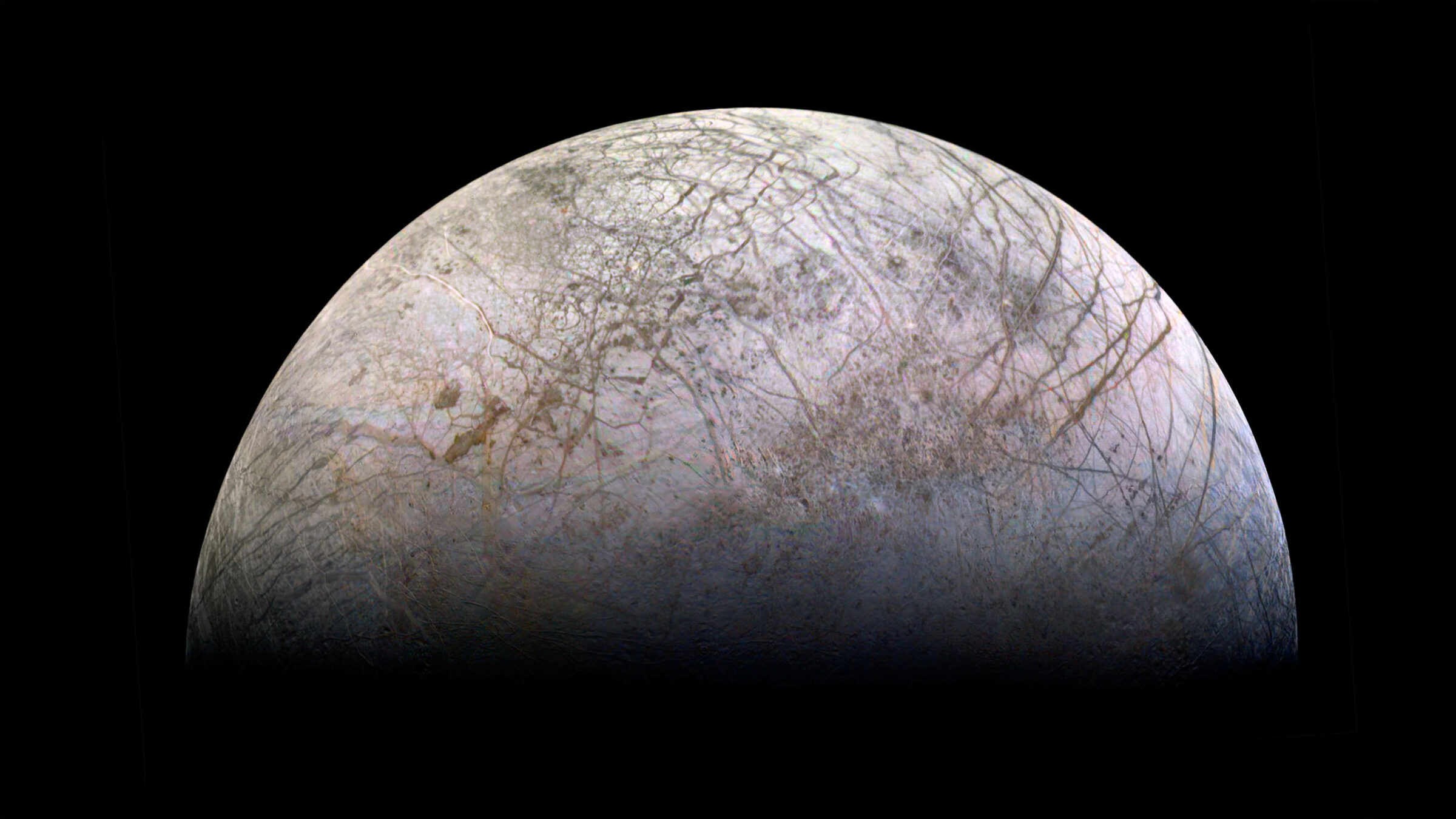Europa, Jupiter’s possible watery moon
Highlights
- Europa has the smoothest surface of any solid body in the Solar System
- Its icy surface may hide a buried ocean full of more water than Earth
- The European Space Agency (ESA) and NASA both have missions planned to visit Europa and other moons of Jupiter
Why we study Jupiter's moon Europa
Europa is the sixth-largest moon in the Solar System and Jupiter’s fourth-largest satellite. Despite its cracked and discolored appearance, it is the smoothest solid object in the Solar System; its highest peaks, of which there are few, only reach a few hundred meters tall, and large craters are rare. The crisscrossed streaks and splotches that run across the terrain are probably mostly due to relatively shallow fractures and different compositions of the ground, not the enormous canyons present on some other worlds.
This smoothness means that the surface of the moon is fairly young, probably tens of millions of years old rather than billions, like some other objects. Somehow, the ice is being resurfaced and smoothed out faster than on many other worlds. The question of why that happens has not been definitively answered yet, but it probably has something to do with what’s below Europa’s surface.
This frigid moon of Jupiter hides a tantalizing secret: a probable sea containing twice as much water as all of Earth’s oceans combined. While the icy shell is hard as a rock, the interior is warmer, heated by the flexing of its iron core and stone mantle. The side of Europa that’s closest to Jupiter experiences a stronger pull than the farther side, stretching the entire moon and probably causing the long cracks that run across its surface as well as heating the interior.
The evidence that there is some sort of water or slush beneath Europa’s surface is fairly strong, based on models of how a buried ocean would affect the ice above it. Measurements of the moon’s magnetic field also hinted that there is some sort of electrically conductive fluid — such as salty water —flowing under the surface. There are even images from the Hubble Space Telescope that appear to show huge plumes of water vapor erupting from Europa’s south pole, although they are not high-resolution enough to be definitive.
If the liquid ocean really is there, it could make Europa an especially promising place to look for life, because liquid water is crucial for life as we know it. But many mysteries remain about this huge moon, from the thickness of the ice shell to the details of what happens beneath it.

Europa facts
Average surface temperature: -160 degrees Celsius (-260 degrees Fahrenheit)
Average distance from Sun: 5.2 AU
Diameter: 1,940 miles (3,100 kilometers), slightly smaller than Earth’s moon
Volume: 15.9 billion cubic kilometers (3.8 billion cubic miles)
Gravity: 1.315 m/s2
Solar day: 3.5 Earth days
Solar year: about 12 Earth years
Atmosphere: Extremely tenuous, mostly oxygen
Missions to Europa
The first reported observations of Europa were made by Galileo Galilei in 1610. Because of this, it and the three other largest moons of Jupiter — Io, Ganymede, and Callisto — are called the Galilean moons. The first hints of water underneath the moon’s surface did not come until 369 years later, when the two Voyager probes flew through the Jupiter system, providing the first detailed images of Europa.
After that brief flyby, Europa was left alone until 1995, when the Galileo spacecraft became the first probe to orbit Jupiter. It remained in orbit for eight years, taking the most detailed data of Europa that we have. At the end of its mission, Galileo didn’t have enough fuel to completely escape the Jovian system, but researchers did not want to leave it there because of fears that it could eventually smash into Europa, contaminating it and making the hunt for potential life there difficult. Instead, they sent the spacecraft to its demise, plunging it into Jupiter.
In 2016, Galileo was replaced with the Juno craft, which is still orbiting Jupiter now. In Sept. 2022 Juno flew closer to Europa than any spacecraft since Galileo, with a closest approach of only 219 miles (352 kilometers) above the surface.
Two more missions are planned to study Europa in the coming years: the European Space Agency’s Jupiter Icy Moons Explorer (Juice), which launched in April 2023, and NASA’s Europa Clipper, which is set to launch in 2024. While Juice will observe Europa, Ganymede, and Callisto, the Europa Clipper mission is planned to make 45 flybys of Europa, maybe even soaring through its water plumes. Though NASA has stated Europa Clipper is "not a life detection mission," the spacecraft will attempt to identify locations beneath Europa's icy crust that could hypothetically support life.
NASA is also studying the possibility of sending a lander to Europa to characterize its subsurface, but the mission did not receive any funding in 2021 so it remains only a concept for now.


 Explore Worlds
Explore Worlds Find Life
Find Life Defend Earth
Defend Earth

